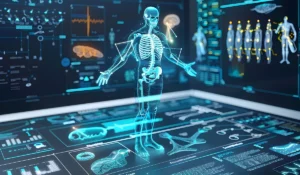Testosterone imbalance in women is nowhere near limited to physical health alone. Here’s something surprising – depression affects about 6% of people worldwide, but women are 1.5 to 3 times more likely to experience it than men. This significant difference made me look into something we often miss: our testosterone levels.
Let’s bust a myth – testosterone is vital for women’s health. Our bodies react strongly to even tiny changes in this hormone, though we have 10-20 times less of it than men do. Any imbalance can trigger mood swings, irritability, and depression. Women’s testosterone levels drop by about 50% between their 20s and menopause. This drop can shake up our emotional health, drain our energy, and cloud our thinking.
In this piece, we’ll get into how testosterone imbalance shows up through different signs – from sudden mood changes to brain fog and lower sex drive. You’ll learn about how both high and low testosterone levels affect women’s mental state. We’ll also cover ways to spot these issues and treatment options that can help balance your hormones and mood.
The First Signs: When Mood Swings Aren’t Just Stress
Your moods feel like they’re on a roller coaster, and you can’t figure out why? Most women blame stress, work pressure, or family responsibilities. But these symptoms might point to something deeper: a testosterone imbalance.
Unexplained irritability and emotional lows
Most people think testosterone is just a “male hormone.” The truth is women need balanced testosterone levels to maintain emotional well-being. Our moods often take the first hit when these levels aren’t stable.
That sudden irritability could be your body’s way of signaling a hormonal issue. Many women tell me they snap at their loved ones over tiny things or feel overwhelmed by situations they used to handle easily. On top of that, emotional lows can sneak up gradually—you might feel unmotivated, sad for no reason, or struggle to enjoy activities you once loved.
A testosterone imbalance can make your emotions feel more intense yet somehow disconnected from real events. This leaves many women wondering why they react so strongly when nothing major has changed in their lives.
How fatigue and brain fog sneak in
Testosterone imbalance shows up in ways that affect your daily life beyond mood changes. You might brush off those afternoon energy crashes or morning grogginess as a need for more sleep.
The exhaustion you feel is different from normal tiredness. You stay tired even after a good night’s sleep. This deep fatigue often comes with what women describe as “brain fog”—you can’t focus, struggle to find the right words, or forget simple things.
Women tell me they’ve lost their mental edge. Simple tasks now take more effort. Reading the same paragraph multiple times or struggling to keep up with conversations becomes common. This mental cloudiness isn’t in your head—it’s a real symptom that comes from hormones affecting your brain function.
Why libido loss might be a hormonal clue
The most telling sign—yet hardest to talk about—shows up as a noticeable drop in sexual desire. Testosterone plays a vital role in women’s libido and sexual response, though many don’t realize this.
Low testosterone levels often cause:
- Less interest in sex
- Lower sensitivity in erogenous zones
- Problems reaching orgasm
- Reduced satisfaction from sex
These changes in desire rarely happen alone. They usually show up alongside mood and energy problems, creating a cycle that affects many parts of your life.
The link between these symptoms makes perfect sense. Testosterone affects your sexual desire, mood balance, energy levels, and mental clarity. So when you notice this combination of mood swings, fatigue with brain fog, and changes in libido, you might want to look at your testosterone levels instead of treating each symptom separately.
Note that spotting these patterns early helps tackle the root cause rather than just treating individual symptoms. These signs might mean more than just stress—your body could be telling you about a testosterone imbalance that needs attention.
Understanding Testosterone Imbalance in Women
Many women don’t know that testosterone—often labeled a “male hormone”—plays a vital role in our overall health and wellbeing. My extensive research in hormone health has made me passionate about clearing this misconception and helping women identify when their testosterone levels aren’t right.
What is testosterone and why women need it
Testosterone belongs to a group of hormones called androgens. Women’s ovaries and adrenal glands produce it at much smaller quantities than men—about 1/10th to 1/20th of male levels [1]. Premenopausal women’s normal testosterone levels range from 15-70 ng/dL [2].
This hormone serves many vital functions in our bodies. Beyond its prominent role in sexual health, testosterone helps maintain:
- Bone strength and density
- Proper ovarian function
- Cognitive abilities and brain function
- Mood regulation
- Energy levels
- Muscle mass and strength
These systems can’t function well without enough testosterone. Research now shows that balancing testosterone and estrogen is vital to ovarian health [3].
Common causes of imbalance: age, stress, PCOS, menopause
Our testosterone levels change substantially as we age. Testosterone production drops by half between our 20s and 40s [4]. Perimenopause and menopause speed up this decline as ovarian function decreases.
Polycystic ovary syndrome (PCOS) causes excess testosterone most often in premenopausal women [2]. PCOS affects 6-10% of women before menopause [3] and creates insulin problems that boost testosterone production [5].
Low testosterone can also result from:
- Surgical removal of ovaries (oophorectomy)
- Adrenal insufficiency (Addison’s disease)
- Pituitary tumors affecting hormone regulation
- Long-term medication use, including certain birth control pills
- Chronic stress affecting adrenal function
Women with PCOS usually reach menopause 2-5 years later than others [5], which shows how hormonal imbalances can change our reproductive timeline.
Signs of testosterone imbalance women often miss
Women might notice mood changes and sexual dysfunction, but many symptoms of testosterone imbalance go unnoticed. High testosterone can cause subtle changes like thinning scalp hair and increased facial or body hair growth [6]. Voice changes and unexplained belly weight gain might happen so slowly that women barely notice [7].
Women with low testosterone often blame their symptoms on aging or busy schedules. They might feel tired and miss the connection between testosterone deficiency and symptoms like dry, brittle skin [2], brain fog [8], and poor sleep [2].
Research suggests that symptoms tell us more than blood tests alone. Women who show clinical symptoms might have “borderline normal” testosterone levels yet still improve with treatment [8]. That’s why tracking physical and emotional changes matters even when lab results look normal.
Learning about testosterone’s role in women’s health helps us address imbalances that might quietly affect our quality of life.
How Testosterone Affects Your Mental Health
Testosterone does more than affect physical health. The sort of thing I love is how this hormone shapes women’s mental health in ways most people don’t realize. The connection between testosterone and emotional wellbeing runs deeper than you might think.
Does testosterone cause mood swings?
There’s no simple answer. Testosterone shapes how our brain handles emotions and reacts to daily experiences. Both too much and too little can throw your moods off balance.
Your testosterone levels affect brain chemicals like serotonin and dopamine that control mood and emotional stability. This hormone helps manage serotonin uptake in the brain and triggers dopamine release [9]. This explains why unbalanced levels can make you feel emotionally unstable without any clear reason.
The hormone also makes nerves and arteries stronger, which supply blood to the brain. This helps mental clarity [10]. Women with unstable levels often experience:
- Sudden irritability and emotional reactions
- Quick mood changes
- Strong reactions to small triggers
- Problems controlling emotional responses
Stress makes everything harder. Stress hormones like cortisol mix with testosterone. This creates a cycle where stress disrupts your hormone levels, and your hormones magnify how you react to stress [9].
Mental effects of high testosterone in females
High testosterone creates specific mental and emotional challenges for women. We noticed these common effects:
More aggressive and impulsive behavior [9]. Research shows extra testosterone might reduce your ability to understand others’ emotions and feel empathy [11]. This can hurt your relationships and social life.
Studies show testosterone affects how your brain’s emotional center (amygdala) works with areas that control thinking [12]. Women with higher testosterone show weaker connections between their amygdala and frontal brain regions. This might reduce their ability to control emotional responses [12].
Women with higher testosterone tend to score lower on friendly personality traits [12]. This might explain why some women don’t deal very well with relationships during hormone changes.
Notwithstanding that, some effects can be good. The right balance of testosterone with other hormones can boost confidence and assertiveness.
The link between testosterone and depression
Testosterone and depression in women share an unexpected pattern. Studies show a curved relationship—too much or too little associates with higher depression risk [13]. Depression symptoms seem lowest when free testosterone levels stay between 0.4-0.6 ng/dL [13].
Depression hits women 1.5 to 3 times more often than men [14]. This suggests hormones play a big part. Studies show mixed results, but menopause matters. A meta-analysis found:
- Depressed women before menopause often have more testosterone
- Depressed women after menopause usually have less testosterone [14]
Note that this relationship isn’t simple. Testosterone levels differ between depressed and non-depressed women. Recent Mendelian randomization analysis suggests testosterone might not directly cause depression [14]. The changed testosterone levels might be depression’s symptom instead.
These findings show how hormones and mental health work together. Women dealing with ongoing mood problems might find new treatment options that balance both hormones and mental health at once.
Getting Diagnosed: What to Ask and Expect
Understanding testosterone imbalance signs marks the first step of your journey. Many patients feel overwhelmed about getting diagnosed, especially since healthcare providers don’t always suggest hormone testing right away.
When to talk to your doctor
Medical attention becomes necessary if persistent symptoms disrupt your daily routine. You should schedule an appointment after noticing irregular menstrual cycles, unexplained irritability, and fatigue that rest doesn’t fix. Your doctor needs to know about sudden weight changes, abnormal hair growth, or recurring acne that occur with mood issues.
Better outcomes usually result from quick action. Your healthcare provider should hear about any persistent changes that last more than two weeks.
Tests for testosterone hormone imbalance in women
A physical examination and symptom discussion start the diagnostic process. Your doctor might order blood tests after the initial assessment to check testosterone levels and other affected hormones.
The Total Testosterone Test accurately measures your blood’s testosterone content. Testing happens in the morning because testosterone levels peak then. Your provider might recommend several hormone tests along with testosterone screening:
- Follicle-stimulating hormone (FSH) test
- Luteinizing hormone (LH) test
- Thyroid stimulating hormone (TSH) test
Why symptoms matter more than numbers
Test results don’t always reveal everything. Women with clinical symptoms often show “borderline normal” testosterone levels yet respond well to treatment. Your symptoms provide better diagnostic insights than lab numbers alone.
A detailed symptom record helps track frequency and severity. This documentation allows your healthcare provider to assess your condition beyond simple blood test results.
Treatment Options and Lifestyle Fixes That Work
After spotting a testosterone imbalance, you’ll need the right treatment plan to restore your hormone balance and make life better. You have several options to deal with high and low testosterone levels, ranging from medical treatments to lifestyle changes.
Testosterone therapy: gels, creams, and implants
Women with low testosterone can benefit from hormone replacement therapy, especially when they have ongoing symptoms that affect their quality of life. The FDA hasn’t approved testosterone treatments specifically for women in the United States, which makes these prescriptions “off-label” [15]. Women need just 5 mg daily—about 10% of what men typically use [16].
You can get testosterone through these methods:
- Topical applications: Gels and creams applied to shoulders, arms or stomach
- Implantable pellets: Placed under the skin in the buttocks area
- Oral medications: Pills and capsules (though less common)
Side effects might show up if the dose isn’t right. These can include acne, excess body hair, hair thinning, weight gain, and body odor [15][16]. Medical supervision is vital since some changes like voice deepening can’t be reversed [16].
Natural ways to support hormone balance
You might want to try some lifestyle changes before turning to medication:
Prioritize quality sleep – Your body makes most of its testosterone during deep sleep, so you need 7-8 hours each night [17]. Poor sleep directly throws off your hormone levels.
Optimize your diet – Load up on zinc-rich foods like nuts, shellfish, and beans [18][19]. Your hormones need healthy fats from fish, avocados, and flaxseeds [18]. Stay away from processed foods, added sugars, and too much alcohol [20].
Exercise consistently – Mix cardio with strength training to boost your testosterone naturally [18]. HIIT workouts seem to work best to balance hormones [20][21].
Manage stress effectively – Long-term stress raises cortisol, which knocks down testosterone [17]. You can try meditation, yoga, and deep breathing to keep your hormones balanced [22].
Tracking your symptoms and progress
The way you feel matters more than lab numbers [23]. Write down your symptoms and notice what changes after starting treatments. This helps your doctor know if they need to adjust anything.
DHEA supplements (25-50 mcg daily) might help some women since it’s a building block for testosterone in your adrenal glands [17][24]. But don’t start any supplements without talking to your doctor first.
It’s worth mentioning that fixing what’s causing the problem—whether it’s stress, poor sleep, or something else—often works better than just treating the symptoms.
Conclusion
Testosterone plays nowhere near the role in women’s health that most of us realize. This piece explores how this significant hormone affects our physical wellbeing and our emotional and mental health. High or low testosterone levels can affect mood regulation, energy, cognitive function, and quality of life.
Many women brush off these symptoms as “just stress” or “getting older.” The signs of testosterone imbalance need recognition to find relief. The link between testosterone and mood might look complex. This connection explains why you feel irritable, foggy, or emotionally disconnected without any clear reason.
Each woman needs a tailored approach to address testosterone imbalance. Some women do well with medical interventions like testosterone therapy. Others see much improvement through lifestyle changes. Your hormonal balance gets natural support from quality sleep, proper nutrition, regular exercise, and stress management. Your body’s signals and symptom tracking matter more than lab numbers alone.
Hormone health works on a spectrum instead of absolute values. Finding your best balance takes time and patience. The right diagnosis and treatment can help you reclaim your emotional wellbeing and energy. Those mood swings and brain fog don’t need to be your normal state. They might just be your body’s way of saying it needs hormonal rebalancing to help you feel like yourself again.
References
[1] – https://www.healthline.com/health/womens-health/do-women-have-testosterone
[2] – https://my.clevelandclinic.org/health/diseases/24897-low-testosterone-in-women
[3] – https://www.health.harvard.edu/staying-healthy/testosterone–what-it-does-and-doesnt-do
[4] – https://mydoctor.kaiserpermanente.org/mas/news/low-testosterone-in-women-symptoms-and-causes-2127551
[5] – https://drbrighten.com/pcos-and-menopause/
[6] – https://www.medicalnewstoday.com/articles/321292
[7] – https://www.healthline.com/health/high-testosterone-in-women
[8] – https://www.bumc.bu.edu/sexualmedicine/publications/testosterone-insufficiency-in-women-fact-or-fiction/
[9] – https://www.menopausespecialists.com/post/the-role-of-testosterone-in-women-s-mental-health-menopause
[10] – https://www.balance-menopause.com/menopause-library/importance-of-testosterone-for-women/
[11] – https://pmc.ncbi.nlm.nih.gov/articles/PMC3044405/
[12] – https://pmc.ncbi.nlm.nih.gov/articles/PMC10607739/
[13] – https://pubmed.ncbi.nlm.nih.gov/11955793/
[14] – https://pmc.ncbi.nlm.nih.gov/articles/PMC7999217/
[15] – https://www.mayoclinic.org/diseases-conditions/menopause/expert-answers/testosterone-therapy/faq-20057935
[16] – https://www.nbcnews.com/health/womens-health/testosterone-women-hormone-replacement-therapy-what-know-rcna179380
[17] – https://www.va.gov/WHOLEHEALTHLIBRARY/docs/Improving-Low-Testosterone-Naturally.pdf
[18] – https://www.medicalnewstoday.com/articles/322508
[19] – https://healthandher.com/en-us/blogs/expert-advice/foods-boost-testosterone-menopause
[20] – https://www.healthline.com/nutrition/8-ways-to-boost-testosterone
[21] – https://www.insidetracker.com/a/articles/how-to-balance-testosterone-and-estrogen-in-females
[22] – https://www.endocrinenyc.com/blog/how-lifestyle-changes-can-help-restore-your-hormonal-health
[23] – https://www.healthline.com/health/hormonal-imbalance
[24] – https://drbrighten.com/low-testosterone-in-women/





